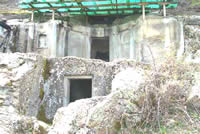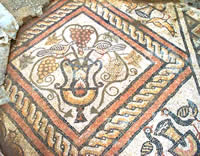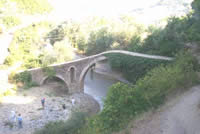| Pogradec

The Pogradec district has been inhabited since the period of the late neolith (6000-2000 BC). Near Buqeza, 20km north of Pogradec, there are prehistoric palaphites built over the surface of the water. The residents of the area are mythological. The monumental tombs of Selca e Siperme speak about their high developed life. Our region has also been inhabited during the Roman time taking a special strategic importance allong the road Via Egnatia.
According to ancient sources, this area has been inhabited by the Illyrian tribes of Enkelean and Dessaret. In their areas, by the end of 5th century BC, was established a powerful Illyrian state with series of settlements and castles around Ohrid Lake such as Enkelana, Lychnidos, Pelion, Sation, Baos etc.
On the hill near to the city of Pogradec is located the place called Kalaja e Pogradecit. The castle was inhabited in the fifth century BC. This was an Illyrian settlement with walls and different types of huts. At the begging it was the castle of the area around it. Later it was inhabited untill the 10th century. After that the inhabitants went down the hill at the place called Gradishte. You can enjoy the beautiful landscape from the top of the hill.
__________________________________________________
Blaca
Near the mountainside of Mali i Thate on the left of the road Korca-Pogradec, about 2-3 km from the Obelisk of Grabovica of the national road, you can take a left and find the village of Blaca. Two hills that are called Kulla and Shpati are located to its north. There are traces of walls and dwelling houses on the top of both hills. A wall, with wide big stones, long nearly 1.5km, surrounds the castle. On the top of the hills are found earthenware, stones for mills, tiles, bricks etc., of the 7-8 centuries BC.
__________________________________________________
Lin
 Lin is a small peninsula on the western shore of Lake Ohrid with a beautiful village of the same name. The houses are made of stone and bricks on the sides of the narrow streets shadowed with grapes. At the south of Lin, near Buqeza, there are some palaphites into the lake in the depth of 2-3 meters. It is a settlement of the lacustrine type built on the surface of the lake as the ones of Maliq (region of Korca). There are opinions that once the peninsula of Lin has been a beautiful island with blooming vegetation. Lin is a small peninsula on the western shore of Lake Ohrid with a beautiful village of the same name. The houses are made of stone and bricks on the sides of the narrow streets shadowed with grapes. At the south of Lin, near Buqeza, there are some palaphites into the lake in the depth of 2-3 meters. It is a settlement of the lacustrine type built on the surface of the lake as the ones of Maliq (region of Korca). There are opinions that once the peninsula of Lin has been a beautiful island with blooming vegetation.
Old Christian Basilica of Lin
The inhabitation of the peninsula of Lin began in the first period of the Iron Age and life there has continued till the early medieval time. During the archaeological excavations an Early Christian basilica with extraordinary floor mosaic from the forth-fifth century of our era was discovered. The mosaics have some beautiful figures such as fish, birds etc.
__________________________________________________ Top
Selca e Poshtme
 At end of Qafe e Thanes when you go to Tirana, please turn to the left to Selca e Poshtme, to visit the five monumental tombs. The castle being in a dominant position of the valley of Shkumbin River played a very important role and of the first hand in the Illyro-Roman and Illyro-Macedonian wars. Near this castle passed Via Egnatia. What distinguish this place are the five monumental tombs engraved in the massive rock of Gradishta. The archaeological excavations have shown that we have to do with a very developed economical-cultural center of a great importance in the 4-3rd centuries BC. At end of Qafe e Thanes when you go to Tirana, please turn to the left to Selca e Poshtme, to visit the five monumental tombs. The castle being in a dominant position of the valley of Shkumbin River played a very important role and of the first hand in the Illyro-Roman and Illyro-Macedonian wars. Near this castle passed Via Egnatia. What distinguish this place are the five monumental tombs engraved in the massive rock of Gradishta. The archaeological excavations have shown that we have to do with a very developed economical-cultural center of a great importance in the 4-3rd centuries BC.
__________________________________________________ Top
The Golik Bridge 
When you turn to left from the road Qafe e Thanes-Tirana and follow the local road, you will enjoy the picturesque valley of the Shkumbin River. Close to the village Golik you will find an ancient bridge from the Roman period known as Golik Bridge or Ura e Golikut in Albanian, part of Via Egnatia. This elegant, triple arched bridge is built, as all the bridges from that time.
__________________________________________________ Top
Saint Bitri Church
The medieval church of Shen Bitri , as the locals use to call this St. Demetrios' church, is several hundred meters away from the village Potkozhan. This small stone building, roofed with stone tiles is very unique because of its two apses on the eastern side and very specific wall painting in its interior. Although the frescoes are damaged, you can still admire the beauty and mystery of the saints pictured on its walls.
__________________________________________________ Top
Via Egnatia
There are some bridges and fragments of the road of Via Egnatia, (the famous road that started from Rome and ended in Constantinople), that begin from the Bridge of Golik , the Bridge of Terziu, bridge in the canyon of Llenga , and Bridge of Nica . The road is distinguished with big stones that are in the stone gorge of Llenga, Canyon of Shkumbin River.
__________________________________________________ Top
Saint Marena Church
The church and monastery of Saint Marena is situated in the north of the village of Llenga, district of Pogradec with a dominated position on the slope of the mountain. The church is a small building, 12 by 8 meters. The altar is separated from the nave with a wooden icon 6m wide and 4m high. The icon is engraved and polychrome with floral motives. All the interior of the church is covered with frescoes that belong to the hand of the headmaster of these areas Kostandin Shpataraku.
__________________________________________________ Top
Pogradec.info provides you with all the information you need to know about the city of Pogradec, including general information, Pogradec hotels and accomodation, transportation, taxi, places to go, Pogradec art and culture, museums, galleries, entertainment, business, dining , Pogradec restaurants, bars, pubs, night clubs, Pogradec shops, Pictures of Pogradec, the weather, useful visitors' tips and more.
|



